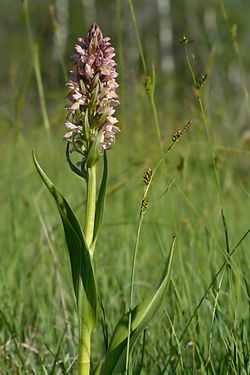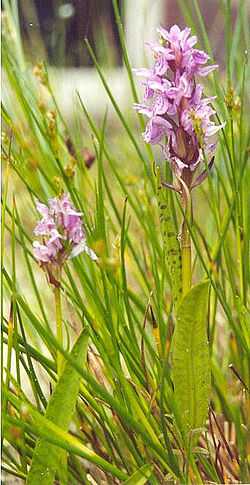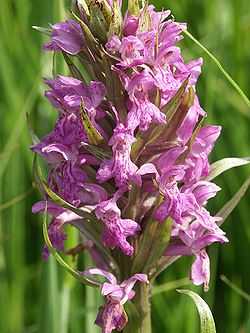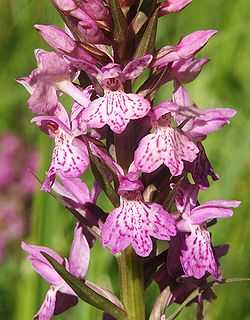Dactylorhiza
| Dactylorhiza | |
|---|---|
| | |
| Common Spotted Orchid (Dactylorhiza fuchsii) | |
| Scientific classification | |
| Kingdom: | Plantae |
| (unranked): | Angiosperms |
| (unranked): | Monocots |
| Order: | Asparagales |
| Family: | Orchidaceae |
| Subfamily: | Orchidoideae |
| Tribe: | Orchideae |
| Subtribe: | Orchidinae |
| Genus: | Dactylorhiza Neck. ex Nevski |
| Synonyms[1] | |
| |
Dactylorhiza (as named by Necker ex Nevski, 1937), commonly called marsh orchid or spotted orchid,[2] is a genus of flowering plants in the orchid family (Orchidaceae). Dactylorhiza were previously classified under Orchis which has two round tubers.[3]
Description
They are hardy tuberous geophytes. In a thickened underground stem, they can store a large amount of water to survive arid conditions. The tuber is flattened and finger-like. The long leaves are lanceolate and, in most species, also speckled. They grow along a rather long stem which reaches a height of 70–90 cm (28–35 in). Leaves higher on the stem are shorter than leaves lower on the stem. The inflorescence, compared to the length of the plant, is rather short. It consists of a compact raceme with 25-50 flowers. These develop from axillary buds. The dominant colors are white and all shades of pink to red, sprinkled with darker speckles.
Taxonomy
Etymology
The name Dactylorhiza is derived from Greek words δάκτυλος "daktylos" (finger) and ρίζα "rhiza" (root), referring to the palmately two- to five-lobed tubers of this genus.
Species
Many species in this genus hybridise so readily that species boundaries themselves are vague, with regular name changes and no clear answers. A few species colonise very well onto fresh industrial wastes such as pulverised fuel ash, where vast hybrid swarms can appear for a decade or more, before ecological succession replaces them.
- Dactylorhiza alpestris : Alpine Dactylorhiza (Pyrenees, Alps, Carpathians).
- Dactylorhiza angustata (France).
- Dactylorhiza aristata : Keyflower (E. China to Alaska).
- Dactylorhiza aristata var. aristata : Keyflower (E. China to Alaska).
- Dactylorhiza aristata var. kodiakensis : Kodiak Keyflower (Aleutian Is. to SW. Alaska).
- Dactylorhiza armeniaca (Turkey) - has become synonym of Dactylorhiza euxina subsp. armeniaca (Hedrén) Kreutz
- Dactylorhiza atlantica Kreutz & Vlaciha (Morocco)
- Dactylorhiza baldshuanica (C. Asia).
- Dactylorhiza baltica (Eastern Europe) (synonym of Dactylorhiza longifolia (Neuman) Aver.)
- Dactylorhiza baumanniana (N. Greece).
- Dactylorhiza baumanniana subsp. smolikana (B. Willing & E. Willing) H. Baumann & R. Lorenz (Greece)
- Dactylorhiza bohemica (EC. Europe).
- Dactylorhiza cordigera (Fr.) Soó (SE. Europe to Ukraine).
- Dactylorhiza cordigera subsp. bosniaca (N. Balkan Pen).
- Dactylorhiza cordigera subsp. cordigera (SE. Europe to Ukraine).
- Dactylorhiza cordigera var. graeca (H.Baumann) Presser)
- Dactylorhiza cordigera subsp. pindica (B. Willing & E. Willing) H. Baumann & R. Lorenz (NW. Greece).
- Dactylorhiza cordigera var. rhodopeia Presser (Greece, Southeastern Europe, Europe)
- Dactylorhiza cordigera subsp. siculorum (Romania to W. Ukraine).
- Dactylorhiza ebudensis (Wief. ex R.M. Bateman & Denholm) P. Delforge : Hebridean Marsh Orchid
- Dactylorhiza elata (Poir.) Soó : Stately Dactylorhiza (W. Europe to NW. Africa).
- Dactylorhiza elata subsp. ambigua (Martrin-Donos) Kreutz
- Dactylorhiza elata subsp. brennensis (W. Europe).
- Dactylorhiza elata subsp. elata (NW. Africa).
- Dactylorhiza elata subsp. mauritanica B.Baumann & H. Baumann (Morocco, Algeria)
- Dactylorhiza elata subsp. sesquipedalis (SW. Europe to Sicilia).
- Dactylorhiza euxina (Nevski) Czerep.
- Dactylorhiza euxina subsp. armeniaca (Hedrén) Kreutz
- Dactylorhiza flavescens (Turkey to C. Asia).
- Dactylorhiza foliosa : Richly-leaved Dactylorhiza (Madeira).
- Dactylorhiza fuchsii (Druce) Soó : Common Spotted Orchid, Fuch's Dactylorhiza (Europe to Siberia).
- Dactylorhiza fuchsii subsp. carpatica (Batousek & Kreutz) Kreutz
- Dactylorhiza fuchsii subsp. fuchsii (Europe to Siberia).
- Dactylorhiza fuchsii subsp. hebridensis (W. Europe).
- Dactylorhiza fuchsii subsp. meyeri (Rchb.f.) Kulikov & E.G.Philippov
- Dactylorhiza fuchsii subsp. okellyi (Ireland, W. Great Britain).
- Dactylorhiza fuchsii subsp. psychrophila (Europe to Siberia).
- Dactylorhiza fuchsii var. sooana (Borsos) Kreutz (Hungary)
- Dactylorhiza fuchsii var. sudetica (Poech ex Rchb.f.) H.Baumann
- Dactylorhiza gervasiana (Sicilia to S. Italy).
- Dactylorhiza graeca (N. Greece) - has become synonym of Dactylorhiza cordigera var. graeca (H.Baumann) Presser)
- Dactylorhiza graggeriana (W. Himalaya).
- Dactylorhiza hatagirea (Pakistan to SE. Tibet).
- Dactylorhiza iberica (Greece to Iran).
- Dactylorhiza ilgazica (N. Turkey) - now synonym of Dactylorhiza urvilleana subsp. ilgazica (Kreutz) Kreutz

(Dactylorhiza incarnata)

(Dactylorhiza praetermissa)
This file is a candidate for speedy deletion. It may be deleted after Monday, 25 August 2014.

(Dactylorhiza majalis)
- Dactylorhiza incarnata (L.) Soó : Early Marsh Orchid
- Dactylorhiza incarnata var. baumgartneriana (B.Baumann, H.Baumann, R.Lorenz & Ruedi Peter) P.Delforge
- Dactylorhiza incarnata subsp. coccinea
- Dactylorhiza incarnata subsp. cruenta (Europe to Turkey).
- Dactylorhiza incarnata subsp. gemmana (W. Europe).
- Dactylorhiza incarnata subsp. incarnata (Europe to Mongolia).
- Dactylorhiza incarnata nothosubsp. krylovii (W. Europe to Siberia).
- Dactylorhiza incarnata subsp. lobelii (Norway to The Netherlands).
- Dactylorhiza incarnata subsp. ochroleuca (Europe).
- Dactylorhiza incarnata subsp. pulchella (Europe).
- Dactylorhiza incarnata nothosubsp. versicolor (Europe)
- Dactylorhiza insularis : Island Dactylorhiza (W. Medit. to WC. Italy).
- Dactylorhiza kafiriana (NE. Afghanistan to W. Himalaya).
- Dactylorhiza kalopissii E.Nelson (N. Greece).
- Dactylorhiza kalopissii subsp. macedonica (J.Hölzinger & Künkele) Kreutz
- Dactylorhiza kalopissii subsp. pythagorae (Gölz & H.R.Reinhard) Kreutz
- Dactylorhiza kulikalonica (C. Asia).
- Dactylorhiza lapponica (Laest.ex Hartm.) Soó (N. Europe).
- Dactylorhiza lapponica subsp. angustata (Arv.-Touv.) Kreutz
- Dactylorhiza lapponica subsp. rhaetica H. Baumann & R. Lorenz (Alps of Austria, Germany, Switzerland, Italy and France)
- Dactylorhiza lapponica subsp. russowii (Klinge) H. Baumann & R. Lorenz (C. Europe to Siberia).
- Dactylorhiza libanotica (Lebanon)
- Dactylorhiza longifolia (Europe to C. Asia).
- Dactylorhiza macedonica (N. Greece) - now a synonym of Dactylorhiza kalopissii subsp. macedonica (J.Hölzinger & Künkele) Kreutz
- Dactylorhiza maculata (L.) Soó : Heath Spotted Orchid, Moorland Spotted Orchid (NW. Africa, Europe to Siberia).
- Dactylorhiza maculata subsp. battandieri (N. Algeria).
- Dactylorhiza maculata subsp. caramulensis (W. Europe).
- Dactylorhiza maculata subsp. elodes (Europe).
- Dactylorhiza maculata subsp. ericetorum : Heath Spotted Orchid (W. Europe).
- Dactylorhiza maculata subsp. islandica (Iceland).
- Dactylorhiza maculata subsp. kolaensis (Montell) Kreutz
- Dactylorhiza maculata subsp. maculata (Europe to Siberia).
- Dactylorhiza maculata subsp. maurusia (Morocco)
- Dactylorhiza maculata subsp. podesta (Netherlands).
- Dactylorhiza maculata subsp. rhoumensis (Great Britain)
- Dactylorhiza maculata subsp. savogiensis (D.Tyteca & Gathoye) Kreutz
- Dactylorhiza maculata subsp. schurii (Carpathians).
- Dactylorhiza maculata subsp. sennia (Vollmar) Kreutz
- Dactylorhiza maculata subsp. transsilvanica (SC. & SE. Europe).
- Dactylorhiza magna (C. Asia).
- Dactylorhiza majalis (Rchb.) P.F.Hunt & Summerh. : Broad-leaved Marsh Orchid, Western Marsh Orchid, Fan Orchid, Common Marsh Orchid (Europe).
- Dactylorhiza majalis var. brevifolia (Rchb.f.) Kreutz
- Dactylorhiza majalis subsp. calcifugiens (Denmark)
- Dactylorhiza majalis subsp. majalis (Europe).
- Dactylorhiza majalis subsp. occidentalis (W. & SW. Ireland, N. Great Britain) (synonym of Dactylorhiza kerryensis (Wilmott) P.F. Hunt & Summerhayes)
- Dactylorhiza majalis subsp. parvimajalis (D.Tyteca & Gathoye) Kreutz
- Dactylorhiza majalis subsp. sphagnicola
- Dactylorhiza majalis subsp. turfosa (Alps to W. Carpathians) - has become a synonym of Dactylorhiza traunsteineri subsp. turfosa (F.Proch.) Kreutz
- Dactylorhiza markusii : Markus' Dactylorhiza (N. Portugal to W. Spain and Italy).
- Dactylorhiza nieschalkiorum (N. Turkey).
- Dactylorhiza occidentalis (Pugsley) P. Delforge : Irish Marsh Orchid (synonym of Dactylorhiza kerryensis (Wilmott) P.F. Hunt & Summerhayes)
- Dactylorhiza osmanica (Turkey to Syria).
- Dactylorhiza osmanica var. anatolica (Turkey).
- Dactylorhiza osmanica var. osmanica (Turkey to Syria).
- Dactylorhiza pindica (NW. Greece).
- Dactylorhiza praetermissa : Leopard Marsh Orchid, Southern Marsh Orchid (W. & NW. Europe)
- Dactylorhiza purpurella (T.Stephenson & T.A.Stephenson) Soó : Northern Marsh Orchid (Great Britain, Ireland).
- Dactylorhiza purpurella var. maculosa (T. Stephenson)
- Dactylorhiza purpurella var. purpurella
- Dactylorhiza purpurella var. cambrensis (R.H.Roberts) R.M.Bateman & Denholm 2005
- Dactylorhiza pythagorae (E. Aegean Is.) - now a synonym of Dactylorhiza kalopissii subsp. pythagorae (Gölz & H.R.Reinhard) Kreutz
- Dactylorhiza romana : Roman Dactylorhiza (Mediterranean)
- Dactylorhiza saccifera (Brongn.) Soó : Sack-carrying Dactylorhiza (Mediterranean).
- Dactylorhiza saccifera subsp. bithynica (H.Baumann) Kreutz
- Dactylorhiza saccifera subsp. gervasiana (Tod.) Kreutz
- Dactylorhiza salina (Caucasus to Amur)
- Dactylorhiza sambucina : Elder-flowered Orchid (Europe). Photos
- Dactylorhiza sudetica (Europe to Siberia)
- Dactylorhiza traunsteineri (Saut. ex Rchb.) Soó : Narrow-leaved Marsh Orchid, Traunstein's Dactylorhiza (Europe to W. Siberia).
- Dactylorhiza traunsteineri subsp. carpatica (Slovakia) - has become synonym of Dactylorhiza fuchsii subsp. carpatica (Batousek & Kreutz) Kreutz
- Dactylorhiza traunsteineri subsp. turfosa (F.Proch.) Kreutz
- Dactylorhiza traunsteineri subsp. curvifolia (N. & NE. Europe).
- Dactylorhiza traunsteineri subsp. traunsteineri (Europe to W. Siberia).
- Dactylorhiza traunsteineri subsp. wirtgenii (Höppner) Kreutz
- Dactylorhiza traunsteinerioides (Pugsley) Landwehr (synonym of Dactylorhiza traunsteineri subsp. traunsteineri)
- Dactylorhiza umbrosa (W. & C. Asia to Siberia)
- Dactylorhiza urvilleana (Steud.) H.Baumann & Künkele (N. & NE. Turkey to Iran)
- Dactylorhiza urvilleana subsp. bithynica (H.Baumann) H. Baumann & R. Lorenz
- Dactylorhiza urvilleana subsp. phoenissa B. Baumann & H. Baumann (Lebanon)
- Dactylorhiza urvilleana subsp. ilgazica (Kreutz) Kreutz
- Dactylorhiza viridis : Frog orchid (Subarctic and subalpine Northern Hemisphere).
- Dactylorhiza viridis var. virescens (Temp. Asia, N. America)
- Dactylorhiza viridis var. viridis (Subarctic and subalpine Northern Hemisphere)
Hybrids


Note : nothosubspecies = a hybrid subspecies; nothovarietas = subvariety.
- Dactylorhiza × abantiana (D. iberica × D. nieschalkiorum) (Turkey).
- Dactylorhiza × aldenii (D. iberica × D. kalopissii) (Greece).
- Dactylorhiza × altobracensis (D. maculata × D. sambucina) (France, Austria).
- Dactylorhiza × aschersoniana (D. incarnata × D. majalis) (W. & C. Europe).
- Dactylorhiza × aschersoniana nothosubsp. aschersoniana (W. & C. Europe).
- Dactylorhiza × aschersoniana nothosubsp. templinensis (D. incarnata subsp. ochroleuca × D. majalis) (C. Europe).
- Dactylorhiza × aschersoniana nothovar. uliginosa (D. incarnata subsp.pulchella × D. majalis) (C. Europe).
- Dactylorhiza × baicalica (D. incarnata subsp. cruenta × D. salina) (Siberia).
- Dactylorhiza × balabaniana (D. iberica × D. urvilleana) (Turkey).
- Dactylorhiza × bayburtiana (D. euxina × D. umbrosa) (Turkey).
- Dactylorhiza × beckeriana (C. Europe).
- Dactylorhiza × boluiana (D. nieschalkiorum × D. saccifera) (Turkey).
- Dactylorhiza × bourdonii (D. brennensis × D. incarnata) (France).
- Dactylorhiza × braunii (D. fuchsii × D. majalis) (Europe).
- Dactylorhiza × braunii nothosubsp. braunii (Europe).
- Dactylorhiza × braunii nothosubsp. lilacina (D fuchsii × D. majalis subsp. turfosa) (EC. Europe).
- Dactylorhiza × braunii nothosubsp. monticola (D. fuchsii subsp. psychrophila × D. majalis) (Europe).
- Dactylorhiza × braunii nothosubsp. smitakii (D. fuchsii subsp. sooana × D. majalis) (EC. Europe). te
- Dactylorhiza × breviceras (D. osmanica × D. urvilleana) (Turkey).
- Dactylorhiza × carnea (D. incarnata × D. maculata subsp. ericetorum) (W. Europe).
- Dactylorhiza × carnea nothosubsp. ampolai (D. incarnata subsp. cruenta × D. maculata) (Europe).
- Dactylorhiza × carnea nothosubsp. carnea (W. Europe).
- Dactylorhiza × carnea nothosubsp. maculatiformis. (D. incarnata × D. maculata) (W. Europe).
- Dactylorhiza × claudiopolitana (D. incarnata × D. schurii) (Europe.
- Dactylorhiza × conigerum (D. maculata × D. viridis) (W. Europe).
- Dactylorhiza × csatoi (D. cordigera × D. maculata) (SE. Europe).
- Dactylorhiza czerniakowskae (C. Asia).
- Dactylorhiza × daunia (D. romana × D. saccifera) (S. Europe).
- Dactylorhiza × delamainii (D. elata subsp. sesquipedalis × D. maculata) (SW. Europe).
- Dactylorhiza × dinglensis (D. maculata subsp. ericetorum × D. majalis subsp. occidentalis) (W. Europe).
- Dactylorhiza × dinglensis nothosubsp. dinglensis (W. Europe).
- Dactylorhiza × dinglensis nothosubsp. robertsii (D. maculata subsp. ericetorum × D. majalis subsp. cambrensi) (Great Britain).
- Dactylorhiza × dinglensis nothosubsp. senayi (D. maculata subsp. elodes × D. majalis) (Europe).
- Dactylorhiza × dinglensis nothosubsp. townsendiana (D. maculata subsp. ericetorum × D. majalis) (Europe).
- Dactylorhiza × dinglensis nothosubsp. vermeuleniana (D. maculata × D. majalis) (W. Europe).
- Dactylorhiza × drucei (D. majalis × D. viridis) (W. Europe)
- Dactylorhiza × dubreuilhii (D. elata subsp. sesquipedalis × D. incarnata) (W. Europe).
- Dactylorhiza × dufftiana (D. majalis × D. traunsteineri) (Europe).
- Dactylorhiza × dufftii (D. incarnata × D. traunsteineri) (Europe).
- Dactylorhiza × dufftii nothosubsp. dufftii (Europe).
- Dactylorhiza × dufftii nothosubsp. gotlandica (D incarnata subsp. ochroleuca × D. traunsteineri) (Europe). Tuber geophyte
- Dactylorhiza × dufftii nothosubsp. stenkyrkae (D. incarnata subsp. cruenta × D. traunsteineri) (Europe).
- Dactylorhiza × erdingeri (D. sambucina × D. viridis) (W. Europe).
- Dactylorhiza euxina (NE. Turkey to Caucasus).
- Dactylorhiza euxinavar. euxina (NE. Turkey to Caucasus).
- Dactylorhiza euxinavar. markowitschii (NE. Turkey to Caucasus).
- Dactylorhiza × flixensis (D. incarnata subsp. pulchella × D. traunsteineri.) (Switzerland).
- Dactylorhiza × formosa (D. maculata subsp. ericetorum × D. purpurella) (W. Europe).
- Dactylorhiza × fourkensis (D. baumanniana × D. sambucina) (Greece).
- Dactylorhiza × gabretana (D. incarnata × D. maculata × D. sambucina) (Europe).
- Dactylorhiza × genevensis (D. incarnata × D. latifolia × D. maculata) (Europe).
- Dactylorhiza × godferyana (D. majalis × D. praetermissa) (W. Europe).
- Dactylorhiza × grandis (D. fuchsii × D. praetermissa) (W. Europe).
- Dactylorhiza × guilhotii (D. incarnata × D. viridis) (W. Europe).
- Dactylorhiza × guillaumeae (D. incarnata × D. sambucina) (W. Europe).
- Dactylorhiza × gustavssonii (D. iberica × D. saccifera) (Greece to Turkey).
- Dactylorhiza × hallii (D maculata subsp. ericetorum × D. praetermissa) (W. Europe).
- Dactylorhiza × hallii nothosubsp. hallii (W. Europe).
- Dactylorhiza × hallii nothosubsp. nummiana (D. maculata subsp. elodes × D. praetermissa) (W. Europe).
- Dactylorhiza × hochreutinerana (D. alpestris × D. incarnata) (W. Europe).
- Dactylorhiza × insignis (D. praetermissa × D. purpurella) (W. Europe).
- Dactylorhiza × ishorica (D. incarnata × D. longifolia) (European Russia).
- Dactylorhiza × jenensis (D. maculata subsp. ericetorum × D. traunsteineri) (W. & NC. Europe)
- Dactylorhiza × jestrebiensis (D. bohemica × D. majalis) (EC. Europe).
- Dactylorhiza × juennensis (D. fuchsii × D. lapponica) (C. Europe).
- Dactylorhiza × katarana (D kalopissii × D. saccifera) (Greece).
- Dactylorhiza × kelleriana (D. fuchsii × D. traunsteineri) (Europe).
- Dactylorhiza × kerasovinensis (D. pindica × D. saccifera) (Greece).
- Dactylorhiza × kerneriorum (D. fuchsii × D. incarnata) (Europe).
- Dactylorhiza × kerneriorum nothosubsp. kerneriorum (Europe).
- Dactylorhiza × kerneriorum nothosubsp. lillsundica (D. fuchsii × D. incarnata subsp. ochroleuca) (N. & W. Europe).
- Dactylorhiza × kerneriorum nothosubsp. variablis (D. fuchsii subsp. hebridensis × D. incarnata) (W. Europe). *Dactylorhiza × komiensis (D. hebridensis × D. maculata) (E. Europe).
- Dactylorhiza × kopdagiana (D. iberica × D. umbrosa) (Turkey).
- Dactylorhiza × koutsourana (D. baumanniana × D. smolikana) (Greece).
- Dactylorhiza × kuuskiae (D.longifolia × D. traunsteineri) (E. Europe).
- Dactylorhiza × latirella (D. incarnata × D. purpurella) (W. Europe).
- Dactylorhiza × lehmannii (D. incarnata × D. russowii) (Europe).
- Dactylorhiza × megapolitana (D. fuchsii × D. russowii) (C. Europe).
- Dactylorhiza × metsowonensis (D. kalopissii × D. sambucina) (Greece).
- Dactylorhiza × mixtum (D. fuchsii × D. viridis) (W. Europe).
- Dactylorhiza × mulignensis (D. incarnata subsp. pulchella × D. majalis) (C. Europe).
- Dactylorhiza × nevskii (D. osmanica × D. umbrosa) (Turkey).
- Dactylorhiza × ornonensis (D. elata subsp. sesquipedalis × D. incarnata × D. maculata) (W. Europe).
- Dactylorhiza × paridaeniana (D. elata subsp. sesquipedalis × D. praetermissa) (W. Europe).
- Dactylorhiza × pontica (D. urvilleana × D. viridis) (Turkey)
- Dactylorhiza × prochazkana (D. bohemica × D. maculata) (EC. Europe).
- Dactylorhiza × renzii (D. incarnata × D. nieschalkiorum) (Turkey).
- Dactylorhiza × rizeana (D. euxina × D. urvilleana) (Turkey).
- Dactylorhiza × rombucina (D. romana × D. sambucina) (C. Europe).
- Dactylorhiza × ruppertii (D. majalis × D. sambucina) (Europe).
- Dactylorhiza × salictina (D. pindica × D. smolikana) (Greece).
- Dactylorhiza × serbica (D. incarnata × D. saccifera) (Europe).
- Dactylorhiza × serreana (D. graeca × D. lagotis) (Greece).
- Dactylorhiza × sivasiana (D. umbrosa × D. urvilleana) (Turkey).
- Dactylorhiza × sooi (D. alpestris × D. fuchsii.) (Europe).
- Dactylorhiza × souflikensis (D. baumanniana × D. pindica) (Greece).
- Dactylorhiza × stagni-novi (D. brennensis × D. fuchsii) (Europe).
- Dactylorhiza × szaboiana (D. cordigera × D. sudetica) (SE. Europe).
- Dactylorhiza × transiens (D. fuchsii × D. maculata subsp. ericetorum) (Europe)
- Dactylorhiza × transiens nothosubsp. corylensis (D. fuchsii subsp. hebridensis × D. maculata)
- Dactylorhiza × transienssubsp. ericetorum (Europe). Tuber geophyte
- Dactylorhiza × transiens nothosubsp. transiens (Europe). Tuber geophyte
- Dactylorhiza × turcestanicum (D. umbrosa × D. viridis) (C. Asia).
- Dactylorhiza × vallis-peenae (D. majalis × D. russowii) (C. Europe).
- Dactylorhiza × venusta (D. fuchsii × D. purpurella) (Europe).
- Dactylorhiza × venusta nothosubsp. hebridella (D. fuchsii subsp. hebridensis × D. purpurella) (Great Britain).
- Dactylorhiza × venusta nothosubsp. venusta (Europe)
- Dactylorhiza × viridella (D. purpurella × D. viridis) (W. Europe).
- Dactylorhiza × vitosana (D. saccifera × D. sambucina) (SE. Europe).
- Dactylorhiza × vogtiana (D. iberica × D. incarnata) (Turkey).
- Dactylorhiza × vorasica (D. cordigera × D. sambucina) (Greece).
- Dactylorhiza × weissenbachiana (D. incarnata × D. lapponica) (C. Europe).
- Dactylorhiza × wiefelspuetziana (D. maculata × D. sphagnicola) (W. Europe).
This list follows the World checklist of monocotyledons,[4] periodically amended from the "Orchid Research Newsletter".[5]
Distribution and habitat
These terrestrial orchids grow in basic soils in wet meadows, bogs, heathland and in areas sparsely populated by trees. They are distributed throughout the subarctic and temperate northern hemisphere. It is found across much of Europe, North Africa and Asia from Portugal and Iceland to Taiwan and Kamchatka, including Russia, Japan, China, Central Asia, the Middle East, Ukraine, Scandinavia, Germany, Poland, Italy, France, the United Kingdom, etc. Inclusion of the widespread frog orchid, often called Coeloglossum viride, into Dactylorhiza as per some recent classifications,[6][7] expands the genus distribution to include Canada and much of the United States.[1]
See also
- Italian Group for Research on Wild Orchid
References
- ↑ 1.0 1.1 Kew World Checklist of Selected Plant Families Dactylorhiza
- ↑ RHS A-Z encyclopedia of garden plants. United Kingdom: Dorling Kindersley. 2008. p. 1136. ISBN 1405332964.
- ↑ Foley, M (2005) Orchids of the British isles. Griffin press Publishing Ltd., Cherltenham, UK ISBN 0-9541916-1-7
- ↑ World checklist of monocotyledons.
- ↑ Orchid research Newsletter
- ↑ Kew World Checklist of Selected Plant Families, Coeloglossum viride
- ↑ Bateman, R.M. (2009). Evolutionary classification of European orchids: the crucial importance of maximising explicit evidence and minimising authoritarian speculation. Journal Europäischer Orchideen 41: 243-318. [as Dactylorhiza viridis]
Bibliography
- Box, M.S.; Bateman, R.M.; Glover, B. & Rudall, P. (2008). "Floral ontogenetic evidence of repeated speciation via paedomorphosis in subtribe Orchidinae (Orchidaceae)". Botanical Journal of the Linnean Society 157 (3): 429–454.
- De Hert, Koen; Jacquemyn, Hans; Van Glabeke, Sabine; Roldán-Ruiz, Isabel; Vandepitte, Katrien; Leus, Leen & Honnay, Olivier (2011). "Reproductive isolation and hybridization in sympatric populations of three Dactylorhiza species (Orchidaceae) with different ploidy levels". Annals of Botany 109 (4): 709–720. doi:10.1093/aob/mcr305. PMID 22186278.
- De Hert, Koen; Jacquemyn, Hans; Van Glabeke, Sabine; Roldán-Ruiz, Isabel; Vandepitte, Katrien; Leus, Leen & Honnay, Olivier (2011). "Patterns of hybridization between diploid and derived allotetraploid species of Dactylorhiza (Orchidaceae) co-occurring in Belgium". American Journal of Botany 98 (6): 946–955. doi:10.3732/ajb.1000367. PMID 21653507.
- Hedrén, Mikael; Nordström, Sofie & Bateman, Richard M. (2011). "Plastid and nuclear DNA marker data support the recognition of four tetraploid marsh orchids (Dactylorhiza majalis s.l., Orchidaceae) in Britain and Ireland, but require their recircumscription". Biological Journal of the Linnean Society 104 (1): 107–128. doi:10.1111/j.1095-8312.2011.01708.x.
- Hedrén, Mikael; Nordström, Sofie & Ståhlberg, David (2012). "Geographical variation and systematics of the tetraploid marsh orchid Dactylorhiza majalis subsp. sphagnicola (Orchidaceae) and closely related taxa". Botanical Journal of the Linnean Society 168 (2): 174–193. doi:10.1111/j.1095-8339.2011.01198.x.
- Inda, Luis A.; Pimentel, Manuel & Chase, Mark W. (2010). "Chalcone synthase variation and phylogenetic relationships in Dactylorhiza (Orchidaceae)". Botanical Journal of the Linnean Society 163 (2): 155–165. doi:10.1111/j.1095-8339.2010.01055.x.
- Paun, Ovidiu; Bateman, Richard M.; Fay, Michael F.; Hedrén, Mikael; Civeyrel, Laure & Chase, Mark W. (2010). "Stable epigenetic effects impact adaptation in allopolyploid orchids (Dactylorhiza: Orchidaceae)". Molecular Biology and Evolution 27 (11): 2465–2473. doi:10.1093/molbev/msq150.
- Paun, Ovidiu; Bateman, Richard M.; Fay, Michael F.; Luna, Javier A.; Moat, Justin; Hedrén, Mikael & Chase, Mark W. (2011). "Altered gene expression and ecological divergence in sibling allopolyploids of Dactylorhiza (Orchidaceae)". BMC Evolutionary Biology 11 (1): 113. Retrieved 2015-02-16.
- Paun, Ovidiu; Luna, Javier A.; Fay, Michael F.; Bateman, Richard M. & Chase, Mark W. (2010). "Genomic responses drive adaptation in allotetraploid species of Dactylorhiza (Orchidaceae; Orchidinae)". In Seberg, Ole; Petersen, Gitte; Barfod, Anders et al. Diversity, Phylogeny, and Evolution in the Monocotyledons: Proceedings of the Fourth International Conference on the Comparative Biology of the Monocotyledons and the Fifth International Symposium on Grass Systematics and Evolution. pp. 169–192. Retrieved 2015-02-16.
- Ståhlberg, David & Hedrén, Mikael (2010). "Evolutionary history of the Dactylorhiza maculata polyploid complex (Orchidaceae)". Biological Journal of the Linnean Society 101 (3): 503–525. doi:10.1111/j.1095-8312.2010.01505.x.
External links
| Wikimedia Commons has media related to Dactylorhiza. |
- Flora of North America Genus page
- Dactylorhiza (Orchidaceae) in European Russia: combined molecular and morphological analysis
- Dactylorhiza picture database
- Mayank Thakur and V. K. Dixit , Aphrodisiac Activity of Dactylorhiza hatagirea (D.Don) Soo in Male Albino Rats, Oxford Journals, Medicine, Evidence-based Compl. and Alt. Medicine, Volume 4, Supplement 1, p. 29-31